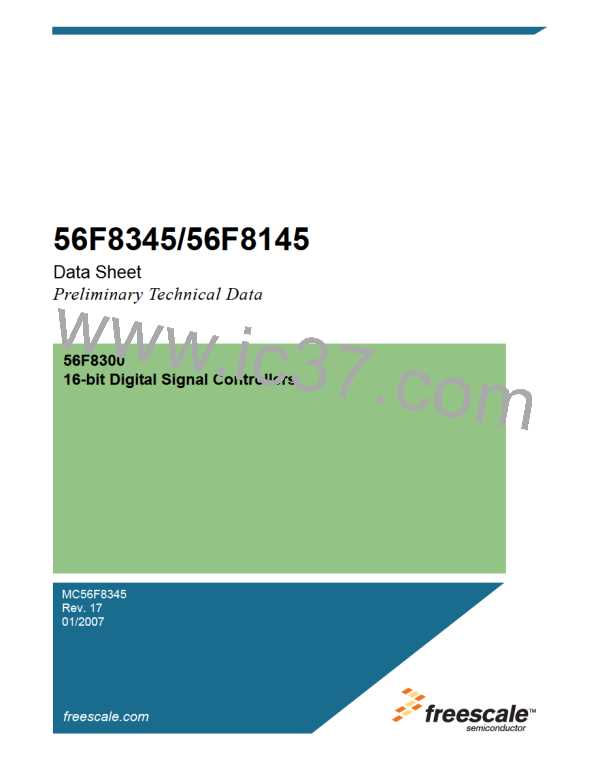Signal Pins
Table 2-2 Signal and Package Information for the 128-Pin LQFP
State
During
Reset
Signal
Name
Pin No.
Type
Signal Description
Home — Quadrature Decoder 1, HOME input
TB3 — Timer B, Channel 3
HOME1
12
Schmitt
Input
Input,
pull-up
enabled
(TB3)
Schmitt
Input/
Output
(SS1)
Schmitt
Input
SPI 1 Slave Select — In the master mode, this pin is used to
arbitrate multiple masters. In slave mode, this pin is used to
select the slave. To activate the SPI function, set the
HOME_ALT bit in the SIM_GPS register. See Part 6.5.8 for
details.
(GPIOC3)
Schmitt
Input/
Port C GPIO — This GPIO pin can be individually programmed
as input or output pin.
Output
In the 56F8345, the default state after reset is HOME1.
In the 56F8145, the default state is not one of the functions
offered and must be reconfigured.
To deactivate the internal pull-up resistor, clear bit 3 in the
GPIOC_PUR register.
PWMA0
PWMA1
PWMA2
PWMA3
PWMA4
PWMA5
ISA0
58
60
Output
In reset,
output is
disabled,
pull-up is
enabled
PWMA0 - 5 — These are six PWMA output pins.
61
63
64
66
104
Schmitt
Input
Input,
pull-up
enabled
ISA0 - 2 — These three input current status pins are used for
top/bottom pulse width correction in complementary channel
operation for PWMA.
(GPIOC8)
Schmitt
Input/
Output
Port C GPIO — These GPIO pins can be individually
programmed as input or output pins.
ISA1
(GPIOC9)
105
106
In the 56F8345, these pins default to ISA functionality.
ISA2
(GPIOC10)
In the 56F8145, the default state is not one of the functions
offered and must be reconfigured.
To deactivate the internal pull-up resistor, clear the appropriate
bit of the GPIOC_PUR register. See Part 6.5.6 for details.
56F8345 Technical Data, Rev. 17
Freescale Semiconductor
Preliminary
31

 FREESCALE [ Freescale ]
FREESCALE [ Freescale ]